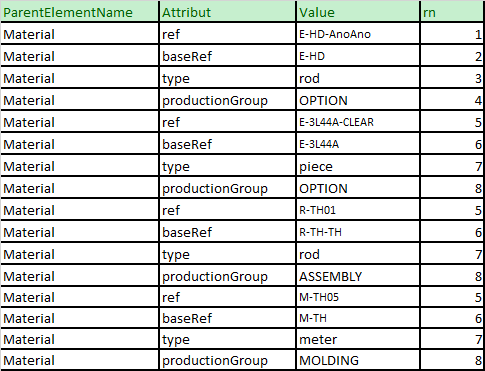Hi @JF Landry ,
I took a liberty and fixed your XML based on my limited understanding of your data.
Check it out.
SQL
-- DDL and sample data population, start
DECLARE @xml XML =
N'<Model xmlns:dsc="ModelDescriptive" xmlns:draw="ModelDraw"
xmlns:display="Display" xmlns:thd="Model3D">
<dsc:Model name="15DE">
<dsc:Defs>
<dsc:Materials>
<dsc:Material ref="E-HD-AnoAno" baseRef="E-HD" type="rod"
productionGroup="OPTION"/>
<dsc:Material ref="E-3L44A-CLEAR" baseRef="E-3L44A" type="piece"
productionGroup="OPTION"/>
<dsc:Material ref="R-TH01" baseRef="R-TH-TH" type="rod"
productionGroup="ASSEMBLY"/>
<dsc:Material ref="M-TH05" baseRef="M-TH" type="meter"
productionGroup="MOLDING"/>
</dsc:Materials>
</dsc:Defs>
</dsc:Model>
</Model>';
WITH XMLNAMESPACES ('ModelDescriptive' AS dsc)
SELECT c.value('@ref', 'VARCHAR(100)') AS [ref]
, c.value('@baseRef', 'VARCHAR(100)') AS [baseRef]
, c.value('@type', 'VARCHAR(100)') AS [type]
, c.value('@productionGroup', 'VARCHAR(100)') AS [productionGroup]
FROM @xml.nodes('/Model/dsc:Model/dsc:Defs/dsc:Materials/dsc:Material') AS t(c);
Output
+---------------+---------+-------+-----------------+
| ref | baseRef | type | productionGroup |
+---------------+---------+-------+-----------------+
| E-HD-AnoAno | E-HD | rod | OPTION |
| E-3L44A-CLEAR | E-3L44A | piece | OPTION |
| R-TH01 | R-TH-TH | rod | ASSEMBLY |
| M-TH05 | M-TH | meter | MOLDING |
+---------------+---------+-------+-----------------+




